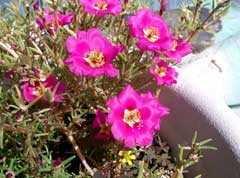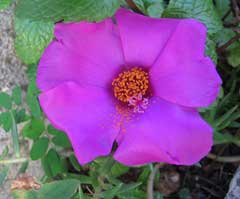 |
|
http://commons.wikimedia.org/wiki/User:KENPEI |
 |
|
Translate this page:
Summary
Physical Characteristics

 portulaca grandiflora is a ANNUAL growing to 0.2 m (0ft 8in) by 0.2 m (0ft 8in).
portulaca grandiflora is a ANNUAL growing to 0.2 m (0ft 8in) by 0.2 m (0ft 8in).
It is frost tender. It is in flower from June to July, and the seeds ripen from July to August. The species is hermaphrodite (has both male and female organs) and is pollinated by Insects. The plant is self-fertile.
Suitable for: light (sandy) and medium (loamy) soils, prefers well-drained soil and can grow in nutritionally poor soil. Suitable pH: mildly acid, neutral and basic (mildly alkaline) soils. It cannot grow in the shade. It prefers dry or moist soil.
UK Hardiness Map
US Hardiness Map
Synonyms
Plant Habitats
Cultivated Beds;
Edible Uses
Edible Parts: Leaves Root Seed
Edible Uses:
Leaves - raw or cooked[105, 161, 177]. Seed - raw or cooked. It can be ground into a powder and used in soups etc, or can be added to cereals[105, 161, 177]. The seed is very small and fiddly to utilize. Root - cooked[177].
References More on Edible Uses
Medicinal Uses
Plants For A Future can not take any responsibility for any adverse effects from the use of plants. Always seek advice from a professional before using a plant medicinally.
Depurative Eczema
The entire plant is depurative[176]. It is used in the treatment of hepatitis, cirrhosis of the liver with ascites, swelling and pain in the pharynx[176]. The fresh juice of the leaves and stems is applied externally as a lotion to snake and insect bites, burns, scalds and eczema[176, 238].
References More on Medicinal Uses
The Bookshop: Edible Plant Books
Our Latest books on Perennial Plants For Food Forests and Permaculture Gardens in paperback or digital formats.

Edible Tropical Plants
Food Forest Plants for Hotter Conditions: 250+ Plants For Tropical Food Forests & Permaculture Gardens.
More

Edible Temperate Plants
Plants for Your Food Forest: 500 Plants for Temperate Food Forests & Permaculture Gardens.
More

More Books
PFAF have eight books available in paperback and digital formats. Browse the shop for more information.
Shop Now
Other Uses
References More on Other Uses
Cultivation details
Prefers a rather dry poor soil in full sun[1, 200]. Succeeds in a hot dry position, and dislikes wet soils[K]. Although a perennial when grown in warmer climates than Britain, it is best treated as a half-hardy annual in this country[1]. There are some named forms selected for their ornamental value[188].
References Carbon Farming Information and Carbon Sequestration Information
Temperature Converter
Type a value in the Celsius field to convert the value to Fahrenheit:
Fahrenheit:
The PFAF Bookshop
Plants For A Future have a number of books available in paperback and digital form. Book titles include Edible Plants, Edible Perennials, Edible Trees,Edible Shrubs, Woodland Gardening, and Temperate Food Forest Plants. Our new book is Food Forest Plants For Hotter Conditions (Tropical and Sub-Tropical).
Shop Now
Plant Propagation
Seed - sow early spring in a greenhouse, pricking out the seedlings into individual pots when they are large enough to handle. Plant out after the last expected frosts. The seed can also be sown in situ in late spring, though the plants will not grow so large this way.
Other Names
If available other names are mentioned here
Native Plant Search
Search over 900 plants ideal for food forests and permaculture gardens. Filter to search native plants to your area. The plants selected are the plants in our book 'Plants For Your Food Forest: 500 Plants for Temperate Food Forests and Permaculture Gardens, as well as plants chosen for our forthcoming related books for Tropical/Hot Wet Climates and Mediterranean/Hot Dry Climates. Native Plant Search
Found In
Countries where the plant has been found are listed here if the information is available
Weed Potential
Right plant wrong place. We are currently updating this section.
Please note that a plant may be invasive in one area but may not in your area so it’s worth checking.
Conservation Status
IUCN Red List of Threatened Plants Status :

| Related Plants
|
| Latin Name | Common Name | Habit | Height | Hardiness | Growth | Soil | Shade | Moisture | Edible | Medicinal | Other |
| Calandrinia balonensis | | Annual/Perennial | 0.1 |
-
| | L | N | DM | 2 | 0 | |
| Calandrinia ciliata | Redmaids, Fringed redmaids | Annual | 0.3 |
0-0
| | LM | N | DM | 2 | 0 | 0 |
| Calandrinia ciliata menziesii | Redmaids | Annual | 0.1 |
-
| | L | N | DM | 2 | 0 | |
| Calandrinia polyandra | Parakeelya | Annual/Perennial | 0.1 |
-
| | LM | N | DM | 2 | 0 | |
| Calandrinia remota | | Annual/Perennial | 0.1 |
-
| | L | N | DM | 2 | 0 | |
| Claytonia acutifolia | Bering Sea Spring Beauty | Perennial | 0.2 |
-
| | LM | N | M | 3 | 0 | |
| Claytonia caroliniana | Broad-Leaved Spring Beauty, Carolina springbeauty | Perennial | 0.1 |
5-9
| | LM | N | M | 3 | 0 | 1 |
| Claytonia exigua | Pale Spring Beauty, Serpentine springbeauty | Annual | 0.1 |
0-0
| | LMH | FSN | DM | 2 | 0 | |
| Claytonia lanceolata | Lanceleaf Spring Beauty, Idaho springbeauty, Pacific springbeauty, Peirson's springbeauty | Perennial | 0.2 |
4-8
| | LM | N | M | 3 | 0 | |
| Claytonia megarhiza | Alpine Spring Beauty | Perennial | 0.2 |
4-8
| | LM | N | M | 3 | 0 | |
| Claytonia perfoliata | Miner's Lettuce | Annual | 0.2 |
6-10
| | LMH | FSN | DM | 4 | 1 | 2 |
| Claytonia scammaniana | Scamman's Claytonia, Scamman's springbeauty | Perennial | 0.2 |
0-0
| | LM | N | M | 2 | 0 | |
| Claytonia sibirica | Pink Purslane, Siberian springbeauty | Annual/Perennial | 0.2 |
3-7
| | LMH | FSN | DM | 4 | 1 | 3 |
| Claytonia tuberosa | Tuberous Spring Beauty | Perennial | 0.2 |
4-8
| | LM | N | M | 3 | 0 | |
| Claytonia umbellata | Great Basin Spring Beauty | Perennial | 0.2 |
-
| | LM | N | M | 2 | 0 | |
| Claytonia virginica | Spring Beauty, Virginia springbeauty, Hammond's claytonia, Yellow Virginia springbeauty | Perennial | 0.2 |
5-7
| M | LM | S | M | 3 | 1 | |
| Lewisia brachycalyx | Shortsepal lewisia | Perennial | 0.2 |
4-8
| S | LM | N | M | 2 | 0 | |
| Lewisia columbiana | Columbian Bitterroot, Columbian lewisia, Wallowa lewisia | Perennial | 0.2 |
4-8
| S | LM | SN | M | 2 | 0 | |
| Lewisia pygmaea | Pigmy Bitterroot, Alpine lewisia | Perennial | 0.1 |
3-7
| | LM | N | M | 2 | 0 | |
| Lewisia rediviva | Bitter-Root | Perennial | 0.1 |
4-8
| | LM | N | M | 2 | 2 | |
| Montia fontana | Water Blinks, Annual water minerslettuce | Annual/Perennial | 0.5 |
0-0
| | LMH | SN | MWeWa | 2 | 0 | |
| Portulaca grandiflora | Rose Moss | Annual | 0.2 |
-
| | LM | N | DM | 2 | 2 | |
| Portulaca oleracea | Green Purslane, Little hogweed | Annual | 0.3 |
3-12
| F | LM | N | M | 4 | 3 | 2 |
| Portulaca oleracea sativa | Golden Purslane | Annual | 0.3 |
-
| | LM | N | M | 4 | 3 | |
| Portulaca retusa | Little hogweed | Annual | 0.2 |
0-0
| | LM | N | DM | 2 | 0 | |
| Sesuvium portulacastrum | Sea Purslane, Shoreline seapurslane | Perennial | 0.2 |
8-10
| | LMH | SN | M | 3 | 2 | 3 |
| Talinum aurantiacum | Orange Flameflower | Perennial | 0.4 |
-
| | LMH | SN | M | 1 | 0 | |
|
Growth: S = slow M = medium F = fast. Soil: L = light (sandy) M = medium H = heavy (clay). pH: A = acid N = neutral B = basic (alkaline). Shade: F = full shade S = semi-shade N = no shade. Moisture: D = dry M = Moist We = wet Wa = water.

Expert comment
Author
Hook.
Botanical References
200
Links / References
For a list of references used on this page please go here
Readers comment
| Add a comment |
|
If you have important information about this plant that may help other users please add a comment or link below. Only comments or links that are felt to be directly relevant to a plant will be included. If you think a comment/link or information contained on this page is inaccurate or misleading we would welcome your feedback at [email protected]. If you have questions about a plant please use the Forum on this website as we do not have the resources to answer questions ourselves.
* Please note: the comments by website users are not necessarily those held by PFAF and may give misleading or inaccurate information.
To leave a comment please Register or login here All comments need to be approved so will not appear immediately.
|
Subject : portulaca grandiflora
|
|
|
|